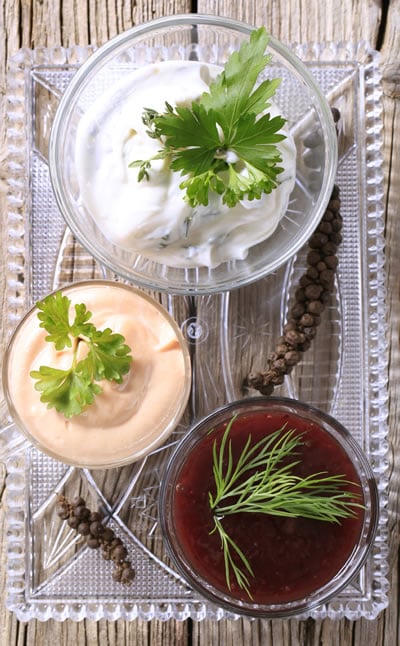10 Tips For Dining Out Healthy
Did you know that you can avoid an entire day’s worth of calories, and loads of salt, sugar, white flour, and saturated fat, by saying “no” to just three things? But it’s also important to know what to say “yes” to. In these 10 tips for dining out healthy, Pritikin’s Director of Nutrition Kimberly Gomer, MS, RD, describes how to cut calories and unhealthy ingredients, but not pleasure.

These 10 tips for healthy dining will help you eat better, cleaner, and leaner. And, as our thousands of guests at the Pritikin Longevity Center have experienced over the past 40 years, they’ll also take you on culinary adventures. You’ll discover new ways of eating that are often more interesting than mainstream fare. So let’s get started!
Check out your local steakhouse. (Yes, you heard me right.)
Tip #1 | Dining Out Healthy
Many of our Pritikin Longevity Center alumni have had great luck at steakhouses. That’s because you can often get really healthy food like fresh greens and other veggies at a salad bar, as well as baked potatoes and steamed vegetables.
Plus, steakhouses are often in the business of preparing meat just the way you want it, including healthful choices like fish and skinless chicken breast. It’s easy to request – and get – no greasy batters or high-salt sauces.
Start out with a big salad (a really big salad).
Tip #2 | Dining Out Healthy
We like to joke that the salad bowls at the Pritikin Longevity Center are so big that they have a diving board on one end. When it comes to fresh greens, colorful veggies, and calorie-light toppings (such as pinto beans and garbanzo beans), there’s no such thing as too much.
And the really good news is that the more calorie-light salad you eat, the less room you’ll have for the more calorie-dense entrees and desserts that follow.
Make your own salad dressing.
Tip #3 | Dining Out Healthy
Salad dressings can make or break both the healthiness and waist-popping potential of any salad. Pour gobs of fat-laden dressing on a salad and you might as well be eating a cheeseburger.

When dining out, ask your server to leave off the regular dressing (which probably adds 400 to 600 calories to your salad).
Here are two delicious alternatives, each much lower in calories (about 5 to 25 calories per two-tablespoon serving).
Wasabi and Rice Vinegar
In Asian-style restaurants, add a lot of kick to your salads by adding a bit of wasabi (known as Japanese horseradish) to rice vinegar. Want it hotter? Add more wasabi. Stir and pour.
Shrimp-Cocktail-Style Dressing
If the menu has shrimp cocktail sauce, ask for some on the side with your salad. If there isn’t any on the menu, make your own. Ask for catsup and a little horseradish, and a little dish to stir up the two ingredients.
Pritikin Salad Dressings
Here’s some exciting news: Our award-winning chefs at the Pritikin Longevity Center are about to roll out four new Pritikin salad dressings in bottles and single-serving packets. The packets will be especially nice for dining out. You can just pop one in your purse or pocket and go.
Both bottles and packets will soon be available online at the Pritikin Store. The dressings’ names are:
- Healthy Honey Mustard
- Heavenly Horseradish Balsamic
- Outrageous Asian
- Tuscan Sunshine Italian
Or for salads, do the fork dip.
Tip #4 | Dining Out Healthy
Get your dressing on the side, in a small bowl. Dip your empty fork into the dressing, then skewer a forkful of salad. You’ll likely be surprised at how nice this tastes, and how little dressing you’ll use. Plus, your lettuce won’t wilt and drown in a sea of oil.
Ask your waiter to “Triple the vegetables, please.”
Tip #5 | Dining Out Healthy
Often a side of vegetables in a restaurant is more like a garnish – a carrot and a forkful of squash. When ordering, ask for three or four times the normal serving of veggies, and offer to pay extra. I’ve never been charged, and I’ve never been disappointed.
Read between the lines.
Tip #6 | Dining Out Healthy
Any menu description that uses the words “creamy,” “breaded,” “crisp,” “sauced,” or “stuffed” is likely loaded with heart-damaging fats like saturated and trans fats.
Other “beware of” words include: “buttery,” “sautéed,” “pan-fried,” “au gratin,” “Thermidor,” “Newburg,” “Parmesan,” “cheese sauce,” and “scalloped.”
Instead, look for descriptors that usually mean a healthier choice, such as:
- Steamed
- Broiled
- Charbroiled
- Grilled
- Poached
- Roasted
- Stir-fried
- Tomato sauce
- Marinara or Marsala sauce
Request no added oils, butter, salt, and/or sugar to any dish. These are the four biggest health and weight saboteurs in restaurant meals.
True, there’s not much you can do about pre-prepared sauces and dressings, but at the very least, your requests will alert the chef to refrain from adding more oil, butter, salt, and sugar.
Opt for pasta instead of pizza.
Tip #7 | Dining Out Healthy
That’s because pizza dough is dense with calories – about 1,250 per pound (and that’s without the cheese, sausage, and pepperoni!)
You’ll take in only half the calories with a pasta arrabbiata (spicy tomato sauce), or vongole (clams with marinara sauce). They each average about 600 to 700 calories per pound.
Better yet, ask for pasta topped with vegetables and no oil, and you’re filling up on just 400 calories per pound.
Also, request whole-wheat pasta. Many restaurants now carry it.
Top your baked potato with veggies from the salad bar.
Tip #8 | Dining Out Healthy
Another great topping choice is salsa. For your waistline and your heart, avoid the butter and sour cream.
Go French and healthy
Tip #9 | Dining Out Healthy
Yes, it’s possible! For an appetizer in French restaurants, try grilled vegetables, fresh asparagus, or steamed artichokes. For a tangy, delicious dipping sauce, mix balsamic vinegar with Dijon mustard.
Good salad choices include a salad of steamed or marinated fresh vegetables, or Salad Nicoise (ask for no oil and no egg yolk).
For your main course, there are several delectable choices, such as roasted chicken, grilled chicken or seafood, poached salmon, bouillabaisse (fish stew), or a petite filet mignon. If you’re watching your blood pressure, you’re better off staying away from the bouillabaisse because the broth is probably loaded with salt.
Above all, be assertive.
Tip #10 | Dining Out Healthy
Dining out is no time to be a meek consumer. And restaurant personnel are often more than happy to accommodate special requests. They know that a happy diner is a diner who returns.
If an entree is described on the menu as fried, ask for it grilled.
For dishes that are stir fried or sauteed, ask that they be either steamed or prepared with broth or wine rather than oil or butter.
If your plate is paired on the menu with French fries, ask instead for a side of veggies, a salad, or a baked potato.
Ask for a smaller portion of the meat and a larger portion of the salad.
For dessert, skip the gooey cheesecake. One slice can easily tally up 30 grams of saturated fat (the equivalent of three Big Macs.) Instead, ask for fresh raspberries or strawberries. Sweet doesn’t get any better! If you want a little richness to your strawberries, ask for a tablespoon of Marsala on top.